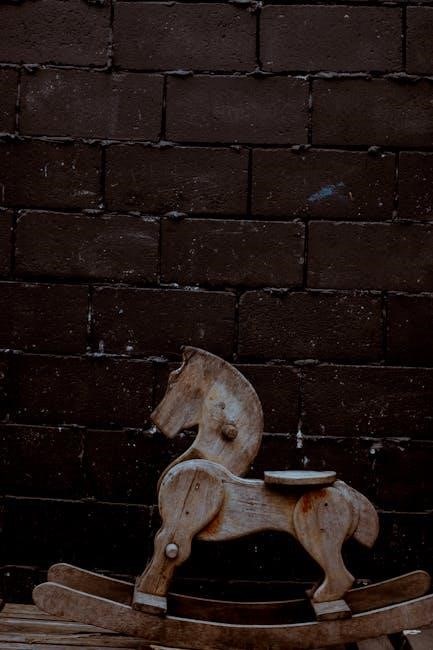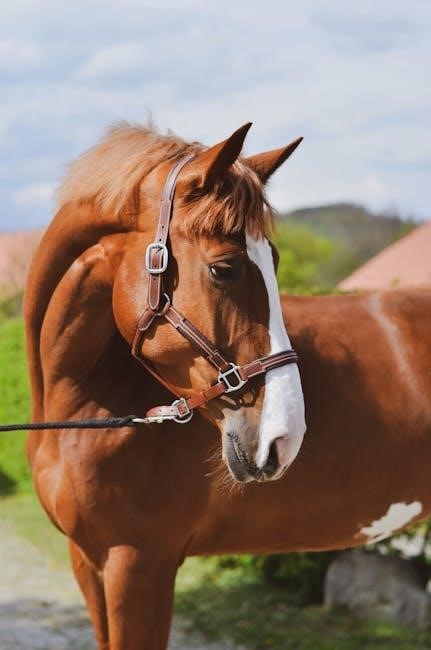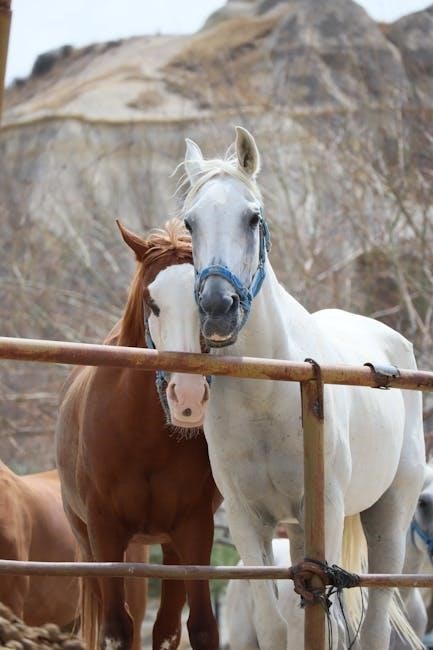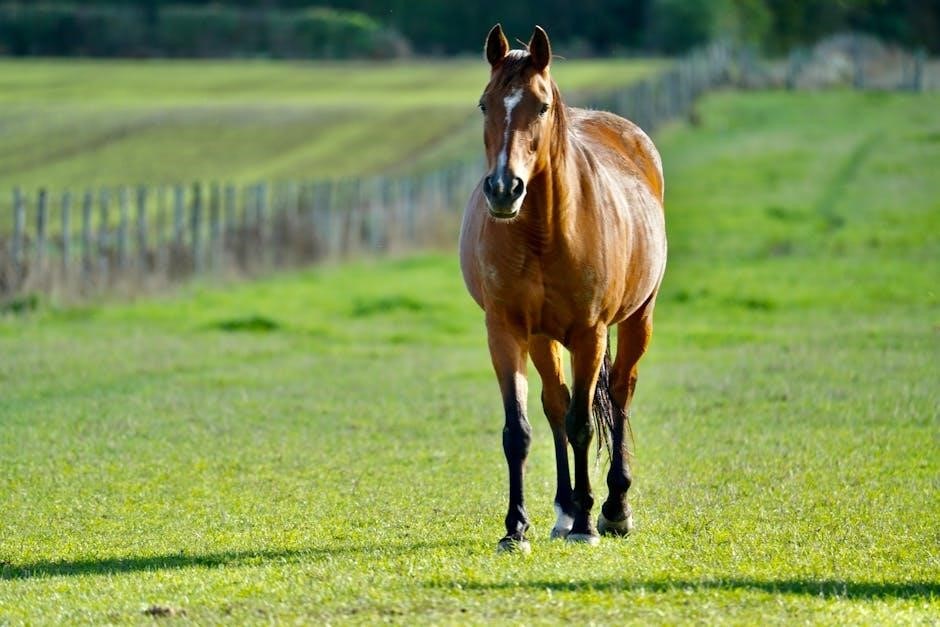Rocking horse plans in PDF format offer a delightful DIY woodworking project, providing detailed instructions and patterns for crafting a charming, durable toy. Perfect for all skill levels, these free plans ensure a timeless gift for generations to cherish.
Why Build a Rocking Horse?
Building a rocking horse is a rewarding DIY project that offers a sense of accomplishment and creativity. It creates a timeless, cherished gift for children, promoting imaginative play and enduring memories. With free PDF plans, the process is cost-effective and accessible, allowing woodworkers of all skill levels to craft a durable, beautiful toy. This project combines traditional craftsmanship with modern convenience, resulting in a treasured family heirloom that spans generations.
The Joy of DIY Woodworking Projects
DIY woodworking projects, like building a rocking horse, offer a sense of fulfillment and creativity. Working with wood allows you to bring ideas to life, fostering a connection to traditional craftsmanship. These projects provide an opportunity to learn new skills, experiment with designs, and create something meaningful. The joy lies in the process of transforming raw materials into a functional, beautiful piece, knowing it will become a cherished family heirloom. This hands-on approach encourages patience, precision, and pride in one’s work, making it a truly rewarding experience.
Creating a Timeless Gift for Generations
A rocking horse crafted from free PDF plans becomes a cherished family heirloom, offering lasting joy across generations. It’s a heartfelt gift that captures the essence of childhood, providing countless hours of entertainment and creating lasting memories. Building one with care and precision ensures it withstands the test of time, becoming a treasured possession for children and grandchildren alike. The effort and love invested in its creation make it a meaningful symbol of tradition and craftsmanship, ensuring its value endures for years to come.

Benefits of Using Free Rocking Horse Plans
Free PDF plans offer a cost-effective, accessible way to create a rocking horse, providing detailed instructions for a fun and rewarding DIY woodworking experience for all skill levels.
Cost-Effective Solution for Woodworking Enthusiasts
Free rocking horse plans in PDF format provide an economical way for woodworking enthusiasts to create a cherished toy without hefty costs. These downloadable plans often include detailed instructions, reducing material waste and ensuring efficient use of resources. Ideal for all skill levels, they offer a budget-friendly alternative to purchased plans, making woodworking accessible and affordable while still producing a high-quality, durable rocking horse.
Accessibility of PDF Formats for Easy Printing
PDF formats of rocking horse plans offer unparalleled accessibility, allowing easy downloading and printing from anywhere. Compatible with standard PDF viewers like Adobe Acrobat Reader, these files ensure crisp, clear instructions and diagrams. Scalable to different paper sizes, they provide flexibility for users. Instantly accessible and print-ready, PDF plans eliminate the need for specialized tools, making it simple for woodworkers of all levels to start their project with ease and convenience.
Detailed Instructions for Beginners
Detailed Instructions for Beginners
Free PDF plans for rocking horses often include detailed step-by-step instructions, making them ideal for beginners. These guides typically feature clear diagrams, photos, and material lists, ensuring an easy-to-follow process. Many plans are designed to be comprehensive, covering everything from cutting templates to final assembly. This level of detail helps newcomers build confidence and skills, allowing them to create a professional-looking rocking horse with minimal frustration, even if they’re new to woodworking.

Where to Find Free Rocking Horse Plans
Popular woodworking websites, forums, and open-source platforms offer free PDF downloads of rocking horse plans. These resources provide easy access to detailed designs for DIY projects.
Popular Websites Offering Free PDF Downloads
Several websites offer free PDF downloads for rocking horse plans, providing detailed instructions and patterns. Woodsmith Plans and other woodworking sites offer print-ready PDFs with materials lists and construction notes. Some platforms include bonus SVG files for CNC users, while others provide step-by-step guides. These resources are ideal for DIY enthusiasts, ensuring easy access to high-quality plans. Downloading is straightforward, with many sites offering instant access to start your woodworking project.
Woodworking Communities and Forums
Online woodworking communities and forums are excellent resources for finding free PDF plans for rocking horses. Websites like Woodsmith and specialized forums provide detailed downloads, tips, and support. Members often share their experiences, offering advice and modifications. These platforms foster collaboration, allowing enthusiasts to exchange ideas and learn from each other. They are invaluable for both beginners and experienced woodworkers seeking inspiration or troubleshooting guidance for their projects.
Open-Source Woodworking Projects
Open-source woodworking projects offer freely accessible plans, including rocking horse designs, often in PDF format. These community-driven initiatives provide detailed drawings, instructions, and materials lists. Many platforms encourage collaboration, allowing users to modify and share their adaptations. This approach fosters creativity and innovation, making it easier for woodworkers of all levels to create custom pieces. Open-source resources are particularly useful for those seeking unique or antique designs, such as the 1890-style rocking horse.

Materials Needed for Building a Rocking Horse
Essential materials include durable wood types like pine or maple, screws, bolts, and wood glue. Hardware such as dowels and hinges may also be required for stability.
Essential Woods and Timber Requirements
Building a rocking horse requires durable, high-quality woods like oak, maple, or pine. For stability, 3/4″ furniture-grade plywood is ideal, as it resists warping and provides a smooth finish. Ensure timber is dry and free of knots to prevent weaknesses. Sanded wood ensures safety for children and a polished appearance. Always use sustainably sourced materials to support eco-friendly woodworking practices. Proper wood selection is crucial for a sturdy and long-lasting rocking horse.
Hardware and Fasteners
Sturdy hardware and fasteners are essential for a durable rocking horse. Use high-quality screws, bolts, and nails to secure joints tightly. Galvanized or stainless steel fasteners are ideal for long-lasting stability. Wood glue reinforces bonds, while hinges ensure smooth rocking motion. Dowels or pegs can add strength to joints. Always pre-drill holes to avoid splitting wood. Safety is paramount, so ensure all hardware is securely fastened to prevent loosening over time. Proper hardware selection ensures a safe and stable rocking horse for years of enjoyment.
Finishing Materials for a Polished Look
Sandpaper, varnish, or polyurethane ensures a smooth, durable finish. Paint or wood stain adds color and character, while wax provides a protective layer. Brushes or foam applicators are ideal for even coverage. A clear coat seals the wood, enhancing its natural beauty. For a vintage look, consider distressing or antiquing techniques. Always follow safety guidelines when applying finishes. Proper finishing materials create a polished, professional appearance and protect the rocking horse from wear and tear, ensuring it remains a cherished heirloom for years to come.

Tools Required for the Project
A jigsaw, drill press, and hand saw are essential for cutting. Sanders, clamps, and a chisel set help shape and assemble. Basic hand tools like gouges and a mallet are also needed for detailed work. Safety gear, such as gloves and goggles, is crucial for protecting yourself while working with power tools and sharp materials.
Basic Woodworking Tools
Essential tools for starting your rocking horse project include a tape measure, square, pencils, and marking gauges for accurate measurements. Hand saws or backsaws are ideal for cutting wood, while chisels and hand planes help shape and smooth surfaces. Clamps are crucial for holding pieces in place during assembly. A sturdy workbench and sandpaper ensure stability and a polished finish. Safety glasses and a dust mask are vital for protecting yourself while working. These tools provide a solid foundation for both beginners and experienced woodworkers.
Power Tools for Precision Cutting
Power tools like bandsaws and jigsaws are essential for precise cuts, especially for intricate designs. A bandsaw excels at curved cuts, while a jigsaw handles detailed shapes. CNC routers, though optional, offer unparalleled precision for complex patterns. These tools enhance accuracy and efficiency, making even intricate rocking horse features achievable. Sanders and drill presses also play key roles in smoothing surfaces and creating clean holes. Together, these tools help ensure professional-grade results, making your rocking horse project both durable and visually appealing.
Hand Tools for Detailed Carvings
Hand tools are indispensable for achieving intricate carvings on your rocking horse.Wood carving gouges and chisels are perfect for shaping and smoothing details like the horse’s mane, legs, and facial features. Carving knives allow for precise, handcrafted touches, while hand sanders ensure a smooth finish. Mallets and marking gauges are also essential for accuracy and control. These tools enable artisans to add unique, personalized details, transforming the rocking horse into a masterpiece of craftsmanship and artistry.

Step-by-Step Guide to Building a Rocking Horse
Follow detailed PDF plans to cut, assemble, and finish your rocking horse. Ensure precise measurements, secure joints, and a smooth finish for lasting durability and safety.
Preparing the Plan and Cutting Templates
Start by reviewing the PDF plans carefully, ensuring you understand the layout and measurements. Print the full-size templates provided in the PDF and transfer them onto your prepared wood. Use a jigsaw or bandsaw to cut out the horse body, legs, and rocking platform accurately. Sand the cut edges for a smooth finish before proceeding to assembly. This step ensures precision and sets the foundation for a sturdy, balanced rocking horse.
Assembling the Horse Body and Rocking Mechanism
Begin by carefully aligning and attaching the horse body panels and legs using wood glue and screws or bolts as specified in the PDF plans. Ensure the joints are secure and properly aligned for stability. Next, assemble the rocking mechanism by attaching the rocker arms to the horse’s base. Follow the detailed instructions to ensure a smooth, balanced motion. Double-check all connections for tightness and durability before moving on to the finishing stage. This step requires precision to achieve a sturdy and functional design.
Finishing and Painting the Rocking Horse
After assembling the horse, sand all surfaces to ensure smoothness. Apply a protective coat of primer or sealant before painting. Choose durable, child-safe paint colors and finishes. Allow each coat to dry thoroughly. Consider adding decorative elements like stripes or a mane for character. Finally, apply a clear varnish to protect the finish and enhance the wood grain. Follow the PDF plans for specific finishing techniques to achieve a polished look.
Final Assembly and Quality Check
Once all components are prepared, carefully assemble the rocking horse according to the PDF plans. Ensure all joints are secure and the structure is stable. Check the rocking motion for smoothness and balance. Inspect for any sharp edges or loose parts. Apply a final coat of varnish if needed. Conduct a thorough quality check to ensure safety and durability. Allow the finish to cure completely before use. A well-assembled rocking horse will provide years of enjoyment for children and become a cherished family heirloom.

Customization Ideas
Personalize your rocking horse with unique carvings, vibrant paint jobs, or antique finishes. Incorporate modern or traditional styles to match any home decor, ensuring a one-of-a-kind creation.
Personalizing the Design
Personalizing the rocking horse design allows you to add unique touches, making it truly special. Consider adding engravings, colorful paint jobs, or custom carvings to reflect individual preferences. You can also experiment with different styles, such as modern minimalist or vintage detailing. Choose from various wood finishes or incorporate fabric for a softer look. These personal touches create a one-of-a-kind piece that tells a story, ensuring the rocking horse becomes a cherished keepsake for years to come.
Adding Unique Carvings or Paint Jobs
Enhance your rocking horse with unique carvings or paint jobs to give it a personalized touch. Use wood carving tools to add intricate details like floral patterns or mane textures. For paint jobs, choose vibrant colors or classic finishes to match your desired style. Consider using food-safe paints for a child-friendly option. You can also add a clear coat for durability. These artistic elements make the rocking horse stand out and add character, creating a truly one-of-a-kind piece for any home or gift.
Incorporating Modern or Antique Styles
Blend modern or antique styles into your rocking horse design for a unique aesthetic. For a modern look, opt for sleek lines, minimalist finishes, or bold color schemes. Antique styles can feature intricate carvings, distressed finishes, or traditional ornamentation. Use the 1890s-style plans as inspiration for a vintage feel or experiment with contemporary materials like plywood for a fresh twist. These designs allow you to create a rocking horse that fits any decor, making it a timeless or trendsetting piece for years to come.

Safety Tips for Woodworking
Ensure safety by wearing protective gear, maintaining tools, and keeping workspaces clean. Follow manufacturer guidelines and keep a first aid kit accessible.
Protective Gear and Workshop Safety
When working on rocking horse plans, prioritize safety by wearing protective gear such as safety glasses, a dust mask, and ear protection. Ensure your workshop is well-ventilated to avoid inhaling sawdust and fumes. Keep loose clothing tied back and long hair secured to prevent accidents. Always use proper lifting techniques to avoid strain. Store tools neatly and follow manufacturer guidelines for equipment operation. A clean workspace reduces tripping hazards, and regular tool maintenance ensures reliability and safety.
Avoiding Common Mistakes
To ensure a successful rocking horse project, avoid common mistakes by carefully following the PDF plans. Double-check measurements before cutting wood to prevent errors. Secure all joints properly to maintain stability and avoid wobbling. Sand thoroughly to ensure smooth surfaces, especially for painted finishes. Use clamps to hold pieces steady during assembly, reducing the risk of misalignment. Regularly inspect your work as you progress to catch and correct any issues early, saving time and materials in the long run.
Ensuring Stability of the Rocking Horse
For a safe and durable rocking horse, ensure stability by using the correct rocker length and proper weight distribution. Secure joints tightly to prevent shifting. Sand all surfaces smooth, especially the rockers, to allow even movement. Test the balance before finishing to make sure the horse sits level. A sturdy base and evenly spaced rockers guarantee smooth, stable motion for years of enjoyable use.

Troubleshooting Common Issues
Address common problems like uneven rocking motion or loose joints by adjusting rocker alignment and tightening connections. Sand warped wood and ensure proper weight distribution for stability.
Fixing Uneven Rocking Motion
Fixing an uneven rocking motion involves checking the rocker’s alignment and balance. Ensure the rocker’s curve is consistent and symmetrical. Tighten any loose joints or bolts that may cause instability. Sanding the rocker’s edges to smooth out uneven surfaces can also help. If the issue persists, consider adjusting the rocker’s length or adding additional support brackets for stability. Proper alignment ensures safe and enjoyable use of the rocking horse.
Repairing Loose Joints
Loose joints in a rocking horse can be repaired by reinforcing the connections with wood glue and clamps. Tightening bolts or screws may resolve minor issues. For more severe cases, disassemble the joint, apply wood filler, and let it dry before reassembling. Sanding the area ensures a smooth finish. Using dowels or wood screws can add extra stability. Always refer to the PDF plans for specific instructions to maintain the rocking horse’s structural integrity and safety.
Dealing with Warped Wood
Warped wood can occur due to moisture or improper drying. Allow the wood to acclimate to the workshop environment before proceeding. Use clamps or weights to gently straighten the wood, ensuring it dries evenly. Sanding and applying wood filler can correct minor warping. Always check for proper fit during assembly to prevent further issues. Consult the PDF plans for specific recommendations on handling warped wood to ensure a sturdy and durable rocking horse.

Additional Resources
Explore recommended books, tutorials, and online communities for further guidance. Video guides offer visual learning, while forums provide support and tips for your rocking horse project.
Recommended Books and Tutorials
Enhance your woodworking skills with books like Woodsmith Rocking Horse Plans, offering detailed tips and techniques. Online tutorials provide step-by-step guides, while video resources cater to visual learners. Communities like Woodworking Project Paper Plan and Rocking Horses & Riders Wood Toy Plans share expert advice. These resources ensure a smooth and enjoyable building experience, whether you’re a novice or an experienced craftsman.
Online Communities for Support
Join vibrant online forums and communities to connect with fellow woodworkers. Websites like Woodsmith and specialized woodworking groups offer free PDF plans and expert advice. Engage in discussions, share tips, and troubleshoot common issues. These platforms provide invaluable support, ensuring your rocking horse project is successful and enjoyable. Active participation fosters creativity and helps you refine your craftsmanship with guidance from experienced makers.
Video Guides for Visual Learners
Video guides provide step-by-step visual instruction, making it easier to follow rocking horse plans. Platforms like YouTube offer tutorials that complement free PDF plans, demonstrating techniques for assembly, carving, and finishing. These videos are ideal for visual learners, showcasing how to measure, cut, and sand accurately. Many creators share tips for smooth assembly and troubleshooting, ensuring your project turns out perfectly. They’re a valuable resource for both beginners and experienced woodworkers, enhancing your DIY experience.

